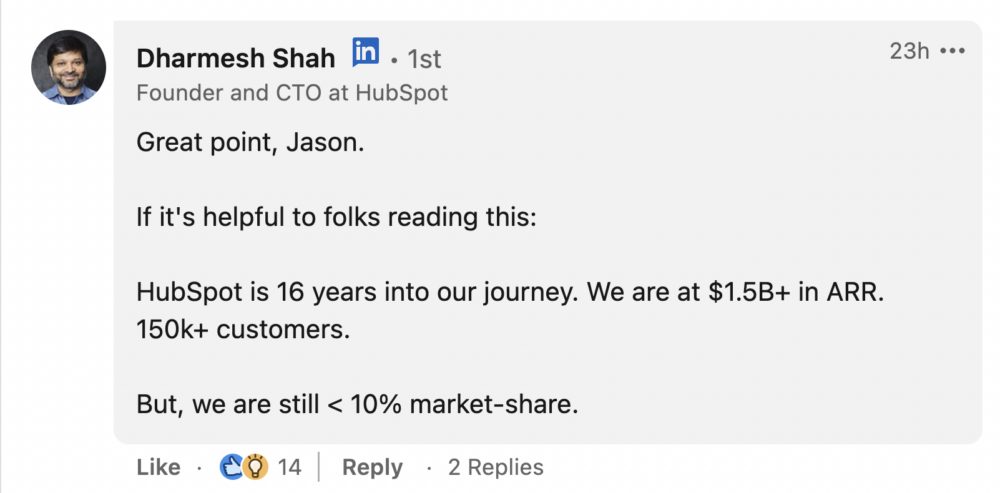 I have a strong, semi-proven thesis that in SaaS, market size doesn’t matter that much … at least in the traditional top-down sense.
I have a strong, semi-proven thesis that in SaaS, market size doesn’t matter that much … at least in the traditional top-down sense.
Yes, many of the big winners in SaaS entered already large markets, from CRM (Salesforce) to ERP (Workday) to Collaboration (Workday, Asana). But others started off in what seemed like … material but smaller markets. Like Shopify and Okta, to pick two. Or of my investments, ones like Algolia and Salesloft, that yes, in theory, were playing in larger markets, but in practice, their entry points were quite narrow.
If you can get to $2m in ARR in 2 years, you can get to $4m the next. From there, it’s on to $10m in ARR. And if you can get to $10m in ARR in, sa,y 4 years … and that compounds, as it will … you have a real shot at $100m. For real. It will be incredibly hard, yes. You may not get there, yes. But if you can get to $10m in any reasonable amount of time … your market is big enough to get you to $100m.
As we’ve talked about before, it’s a 7-10 year journey to get there (~$100m in ARR) for most SaaS companies, outliers aside.
And it’s better than that, these days. Because SaaS markets are just continuing to grow. It was just a little while ago that Salesforce was doing $1 billion in ARR revenue. Now they’re a good chunk of the way to $10 billion. Same software, dude. Some solid updates, yes. But same software. The SaaS markets are growing faster than ever …
So when you’re trying to figure out how big it can all be for your SaaS start-up, I know you’re gonna put together a nice “Total Addressable Market” slide. It’s going to show us all how you’re playing in a Billion Dollar Market. That’s great.
But quickly, move on. The #1 best recommendation I can give for you to learn, at Day 0, and in the early days, is — Build a REAL, Bottom-Up Model, That Shows How You’ll Get to $100m in ARR in 7 Years. And make sure you believe it. Build it for you:
- How will you get your customers? And what mix?
- What will your ACV really be?
- How can that scale over time?
- What evidence is there that you can charge what you think you’ll be able to?
- How many sales reps, how much marketing spend, how many engineers will you really need?
- What will it really, truly cost?
- How will your conversion funnel work? Does it make sense, and scale, from an input-output perspective?
- How will you fund it?
And then get help. Make sure your assumptions are crystal clear, and then have really smart, experienced SaaS executives (including marketers) review them and challenge you. And make sure you really, really understand the public company comps. Because you can learn so much from comps … just read their S-1s, 10Qs, and the like.
I did this myself, not as effectively as I could do today, but it was eye-opening:
- It showed that we’d never get there ($100m) on freemium alone. Ever. And true enough … freemium only ended up being 20% of our revenue, at least strictly defined.
- It also showed me we needed more money than I’d thought. So we raised an extra $600k. We probably should have raised $2m more, since it was offered. And the model said we’d need it …
- It also showed me that, barely, if you squinted, and the market grew just right … by 2013, there’d be $100m in ARR in our space. And so it is, although we didn’t capture 100% of it. 😉
My point: If you want to do something really worth your time in SaaS. Worth hiring a sales team, raising some venture capital (even a modest amount). Worth investing 7+ years of your life in. Then at least believe you can hit $100m in ARR in 7 years. For real, from a real bottom-up model.
And I can say now, looking at 30+ venture investments, the ones where TAM held them back, in the end, were ones where they couldn’t really do the above analysis. Where they didn’t have a true, clear path to $100m ARR.
Even if you come up short, and/or even if it takes much longer, you’ll then have a real solid chance of creating something of value. And if you don’t know how to get there … if you can’t honestly build a real, data-driven model that proves it at least to you … then that’s awfully telling.
(note: an updated SaaStr Classic post)
A related post here:


